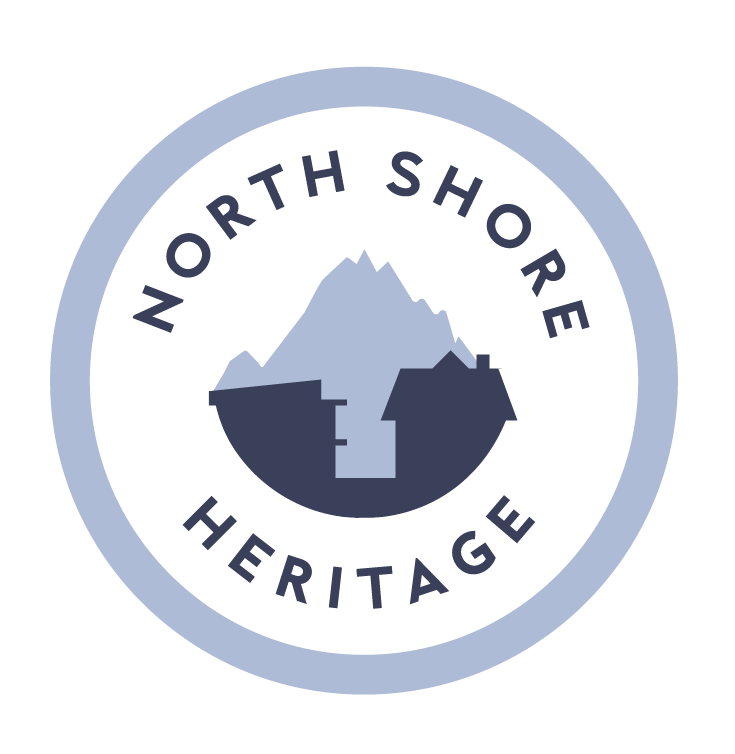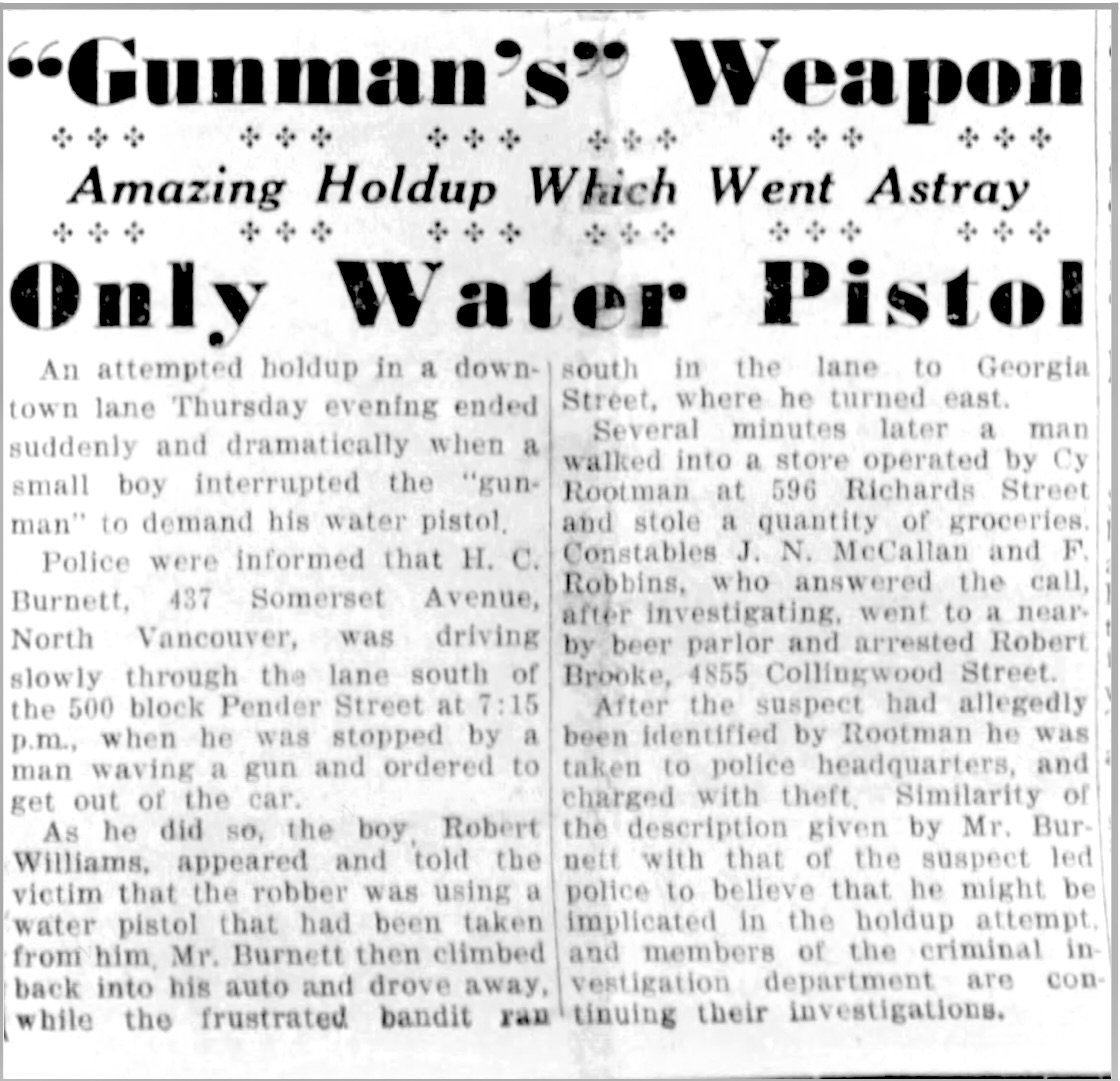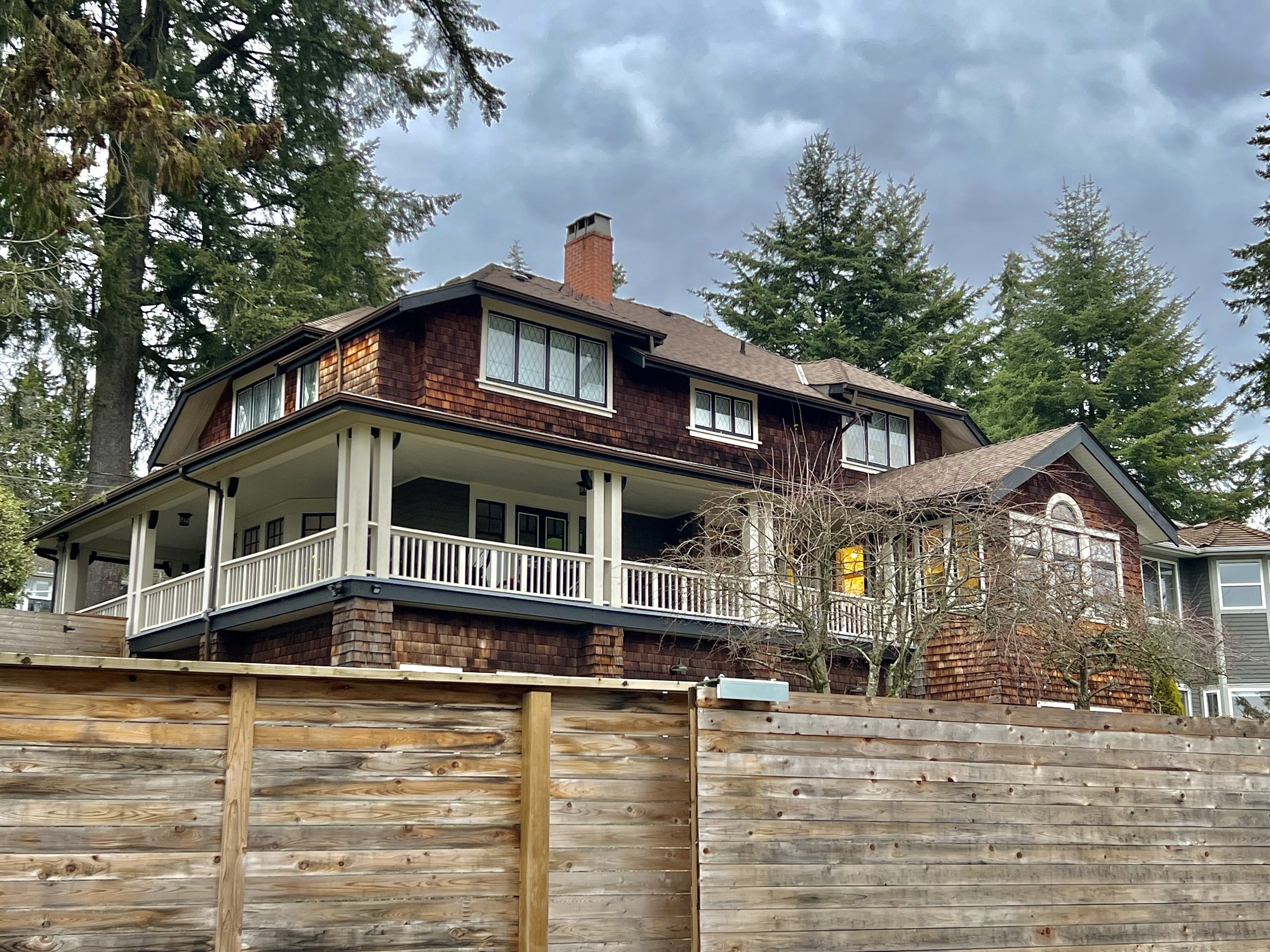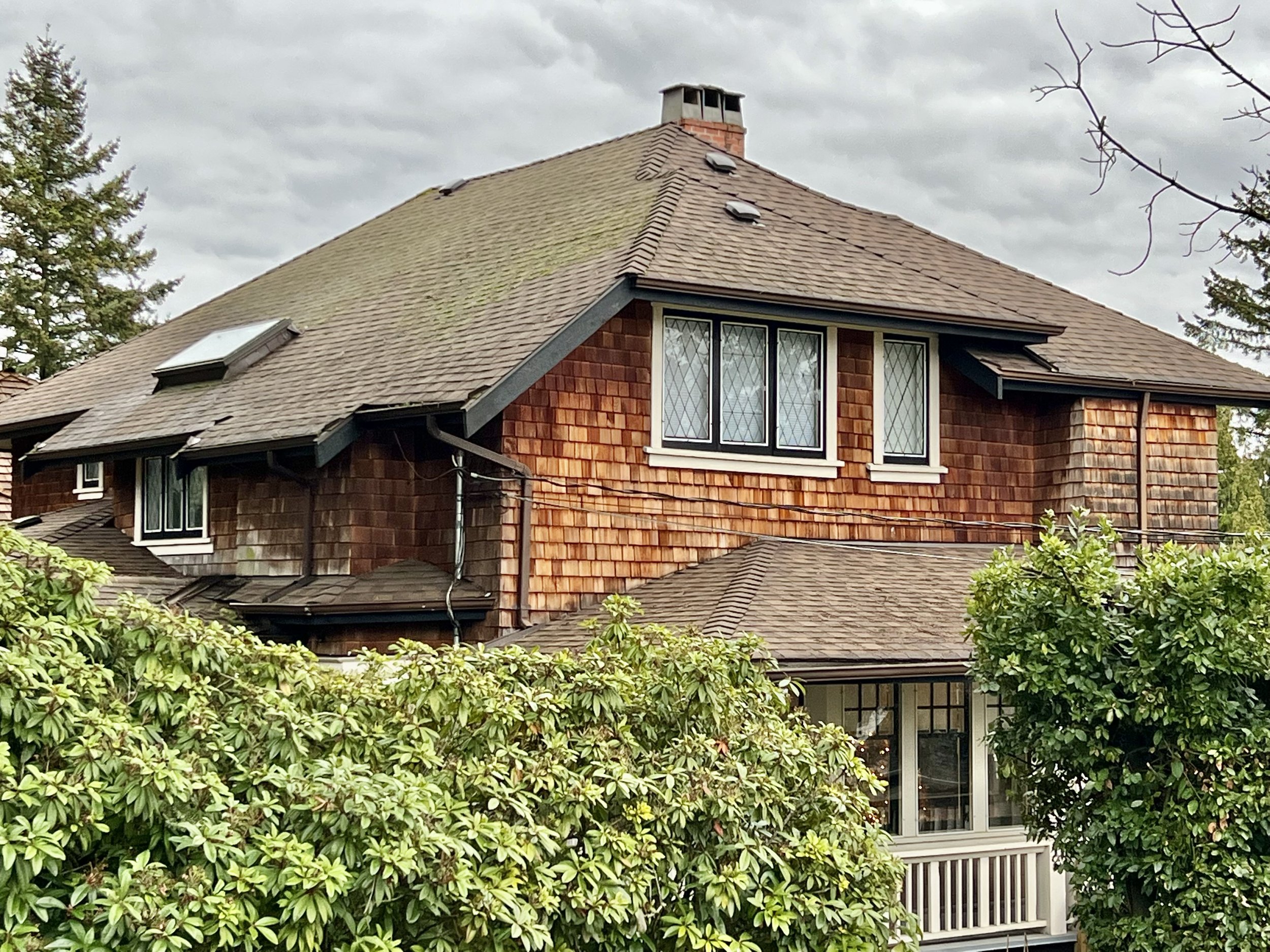A 1916 snowy view of 437 Somerset, courtesy of MONOVA: Archives of North Vancouver, inv.#6645
Some houses really seem to attract interesting occupants and owners! Or is that interesting people are attracted to certain houses? Either way, some houses have had so many occupants with fascinating histories and adventures that it’s hard to imagine there isn’t something special or unusual going on in that respect.
Built in 1912, the Heritage A designated house at 437 Somerset (also known as Tempe House) was designed by architects Rayburn Jameson and Creighton E. Duggan, and has had many different people living there since its completion. It seems that historically, so many of its occupants have had either charisma, talent, creativity, ambition, or all of the above. In short, characteristics that made a person dynamic and a mover and shaker of some sort. It’s easy to see why so many were attracted to this home. With its stunning view of Burrard Inlet, wrap-around porch, classic design and spacious rooms, it has always been a catch of a house.
Some of the occupants and owners have already been written about extensively, so I’ll keep the biographies short, but others haven’t had much mention so I’ve put together a virtual scrapbook of sorts, showcasing well-known but also the lesser written-about occupants, and some of their related newspaper clippings and photos in a scrapbook format. This is by no means an exhaustive list, but discusses quite a few of them.
JOHN MAGNUS
Newspaper clip taken from The Daily News Advertiser, Nov, 17th, 1912, from newspapers.com
The City of North Vancouver, in its 2013 Heritage Register, states that the first owner of Somerset was a realtor, John Magnus. He was one half of the North Vancouver realty partnership, Magnus and Moorewood. Not much has been written about him, but I found this poem in a 1912 newspaper, and chances are high that this is the same person, given the small population in North Vancouver at this time.
The poem seems excessively dramatic, and at times, some of the descriptions like “volcanoes vomit” and “belched out from the mighty womb of space” are debatably humorous by today’s standards, and yet there is something endearing about the ardent style of the poet. If this is the John Magnus of 437 Somerset, it makes sense, since he clearly had an abundance of creative zeal, and this is in keeping with the passionate type that often graced the halls of the home.
CONSTANTINE ALVO VON ALVENSLEBEN
Constantin Alvo von Alvensleben, courtesy of The Vancouver Archives, inv. #AM54-S4 Port P1082
Alvo von Alvensleben, the son of a German count, and one of the home’s earliest owners, came to Vancouver in 1904 at age 25, with only $4 and worked his way up into business by taking odd jobs, working hard, saving and investing. He used his natural charisma, dapper style and keen business sense to help him achieve success and took one of the first seats when the stock exchange opened in 1907 in downtown Vancouver. He rented an office and soon after began making a real estate and investment fortune worth millions. He also brought in millions of dollars in investments to BC from European investors. He was able to buy numerous houses, farmland, mines, forestry sites and more, all over BC. His business portfolio was mind-boggling after only a fairly short time in business. He married a teacher from Ladner and had three children. According to Eve Lazarus in her article about the home from 2013, Somerset was used as a hunting lodge, not his main residence, which actually was an even grander house in Vancouver which eventually became what we know today as Crofton House School. During his time there it was said to have a staff of thirteen!
Newspaper clip taken from “The Daily Advertiser” Aug 05, 1906 courtesy of newspapers.com
This was an early ad, only a couple years into his time in Vancouver. Within a few years he had added many other business services to his ads.
Von Alvensleben reportedly brought $60,000,000 into BC from wealthy Europeans investors. Despite being an early investor to the Vancouver economy and having invested a lot of his life in the Vancouver area (he owned numerous homes and buildings around Metro Vancouver aside from Somerset), he was seen as suspicious after WWI broke out, as the anti-German sentiment was growing strong. He fled to the US to Seattle with his wife and children while the Canadian government seized all his assets, including 437 Somerset. Unfortunately, after he fled to Seattle, the suspicion of Germans became high there as well, and von Alvensleben, despite no evidence to support the claim, was soon branded a spy and sent to Utah for three years as a dangerous criminal to an internment camp nicknamed “Little Germany” where he was mistreated, along with others, at times, severely. Even after the war ended, he and others weren’t let go for months longer, with a “just in case” philosophy used as they were still seen as possibly dangerous. It was later surmised that out of the hundreds of prisoners, only 3 were likely real spies, the rest of the prisoners’ only fault was being German during a time of German anti-sentiment and prejudice.
After his internment, von Alvensleben returned to his home in Seattle to be with his wife and family and started on new business ventures, but papers of the day reported that he’d lost a lot of his former spark and that he wasn’t ever the same after he left the camp. Even in his eighties, he maintained his innocence as a spy, telling the Nanaimo Daily News in 1961 that “I was a victim of scandalous falsehoods circulated by enemies and published here in the atmosphere of early war hysteria”.
JOHN DRAINIE
Photo courtesy of newspapers.com from The Vancouver Sun, Oct.14th, 1938
John Drainie, top left, as a young man with his cast mates of “Hotel Universe” with the Vancouver Civic Players in their 1938 production.
The Drainie family moved into the house at Somerset as renters in 1930 when John Drainie was a child, as it was thought that the elevation of the house on the hill would help his brother with his tuberculosis. The whole family was involved in the local theatre scene, and the home leant itself so well to their interests that they used it to put on performances.
Drainie went on to become such a beloved television presenter and radio actor that Orson Welles called him “the greatest radio actor in the world” and he was known as “the man with a thousand voices” because of his uncanny ability to play countless different characters. He could mimic any accent, sometimes playing multiple characters in one show at the same time, and could even do realistic sound effects like the phone ringing! I remember there being a muppet like that on Sesame Street. I wonder if Drainie was the inspiration?
John Dranie was known for his virtuosic talent paired with a tireless work ethic. He sadly died young from cancer at the age of fifty, but contributed greatly to the entertainment world with his talent, hard work and the joy he brought his viewers.
H.C. BURNETT
I wasn’t able to find out much about H.C. Burnett, who lived in the house after the Drainie family, but I found such a strange newspaper article tied to him that I thought it should be included in this “scrapbook” of owners of the house.
Clipping from a Vancouver News-Herald newspaper from 1936 courtesy of newspapers.com
HOME ALMOST DESTROYED BY FIRE IN 1945
Clipping from Mar 07, 1945 edition of The Vancouver Sun, courtesy of newspapers.com
DR. CHARLES HEGLER GUNDRY
Dr. Gundry and his family lived at the Somerset House from 1945 until 1972. Gundry was Vancouver’s first mental health director, or at the time as it was called, “Mental Hygiene Director”. He began his post in 1939 and had the job for thirty years until his death in 1969. Although much has changed in mental health practice since Gundry’s posting, and modern practice may not agree with some of his work and philosophies, he was still a positive force in fighting for mental health services in the Lower Mainland. He thought it necessary to provide schoolchildren with mental health services, and that North Vancouver should have its own mental health unit. He, unlike some other others at the time, believed that treating mental health issues was as vital as treating the rest of one’s physical health issues, and worked to popularise this idea.
Clipping from the Feb. 26, 1947 edition of The Province newspaper from newspapers.com
Gundry’s name was mispelled in this article.
RAY AND BARBARA PERRAULT
The dynamic political duo of Ray and Barbara Perrault lived at the home between 1974-1995. Ray was the leader of the Liberal Party from 1959-1968, then became a Liberal MP, and finally, he was appointed to the Senate by Pierre Trudeau in 1973, becoming Leader of the Government in the Senate. All told, he spent 40 years in office, retiring from the Senate in 2001. Barbara, a former teacher, served six terms as a City Councillor for the City of North Vancouver, spent time on the North Vancouver Heritage Advisory Committee, and worked for thirty years as a volunteer community worker.
This snippet was taken from an article written as Perrault ran for re-election as an MP of Burnaby-Seymour, a couple of years before he and Barbara moved to Somerset. It chronicled a day in the life of his campaign and showed such an honest, hardworking, no-nonsense approach that I found intriguing. It was an interesting snapshot not only of Perrault’s approach to politics, but also of the times. The author, Neale Adams, notes that Perrault headed out, after a busy morning starting out with a Leadership breakfast event at the Bayshore Inn, in a rented car to do his canvassing. The clipping continues from that point.
Clipping from Vancouver Sun article, Oct. 17th, 1972, from newspapers.com
Vancouver Sun, Oct. 25, 2002, from newspapers.com
The title of this short 2002 Vancouver Sun article caught my eye and I appreciated Perrault speaking to the press about this matter. It was titled North Vancouver City councillor laments low number of women on election slate
Looking to the future of heritage in 2023
A house like 437 Somerset is a shining example of how a "heritage house" is more than just four walls! Of course, every heritage house has its own unique architecture that makes it beautiful but what really makes it come alive are the stories about the people who lived there! It’s not that the stories are necessarily lost forever when we lose a heritage home, but without the home standing there as a constant reminder of its storied history (pun intended!), the stories lose their context and over time, become less relevant. Our future depends partly on learning from the past and its people, and although I’m grateful that 437 Somerset is still standing, many other heritage homes with incredible stories within their walls were lost to the bulldozer or to neglect in 2022 and countless previous years. My heritage wish for 2023 is that we can save more than we lose, and that we keep as many of our stories - and the homes they come from - as we can.
And if you live in a heritage house and want to know more about the families who lived there, please let us know and we can help you learn more about its story!
Two current views of the home. The front view is a bit obscured by the fence but you can still see the basic structure is much the same as the historical photo save for the bump out from the porch area on the far right. The second view is of the back corner and shows the lovely diamond paned windows. The view from the back belies the grand nature of the house as shown from the front.
Photos by Jenny Morgan
INTERESTING SIDENOTES
The house was originally on two and half lots, but in the comments to Eve Lazarus’s blog post on the home, the owner from 1995-2000 wrote that she was afraid if the house was sold one day that a developer would buy the property, tear the house down and build two houses. Her solution was to move the house over a little to make the property sub-dividable, sell the other lot and hopefully protect the home. It worked. She sold the house after 5 years and the subsequent owners have kept the house intact. I’m grateful for her foresight into this and the effort to move the home!
There are other fascinating comments in Eve’s blog from previous owners and neighbours such as ghost sightings. You can read about them below in the Further Reading section.
In Chuck Davis’s book The Chuck Davis History of Metropolitan Vancouver, his format is to write short notes about important things that happened year by year in the city. By strange coincidence Alvo von Alvensleben and John Drainie are listed one after the other as being notible deaths for the year 1965. Although Alvensleben was 86 and Drainie 49, they died within 8 days of each other.
Further Reading:
Article about John Drainie by a director who worked with him and admired him greatly.
2013 Blog post about 437 Somerset by Eve Lazarus
Current photos of the house from the last realty listing before it was sold in 2021
SOURCE: MONOVA archives, The Vancouver Archives, City of North Vancouver Heritage Register 2013, newspapers.com ( Nanaimo Daily News, The Vancouver Sun, The Province, The Daily Advertiser, Vancouver News-Herald), deaneterrace.com, evelazarus.com (The Hunting Lodge on Somerset St in North Vancouver and Eve Lazarus’s book (At Home With History: The Untold Secrets of Greater Vancouver Heritage Homes), The Georgia Straight, Chuck Davis: The Chuck Davis History of Metropolitan Vancouver.














